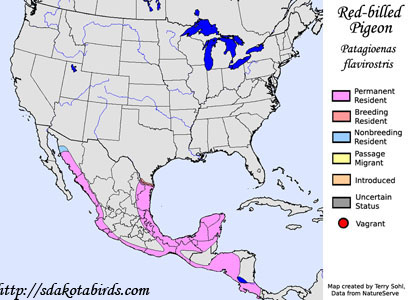| Length: 14 inches | Wingspan: 24 inches | Seasonality: Non-resident in South Dakota |
| ID Keys: Dark grayish overall, rusty-gray neck, head, and wing patch, red bill with pale tip | ||
 The
Red-billed :Pigeon is a large pigeon found mostly in Mexico and Central
America. In the United States, their range just crosses into the far
southern edge of Texas, where they are found in the woodlands along the Rio
Grande river on the Mexican border. They lack some of the distinctive
markings seen on other large pigeon species that are found in North America,
but can be identified by the rusty tones on their head, neck, and breast,
and the small red bill with a pale tip.
The
Red-billed :Pigeon is a large pigeon found mostly in Mexico and Central
America. In the United States, their range just crosses into the far
southern edge of Texas, where they are found in the woodlands along the Rio
Grande river on the Mexican border. They lack some of the distinctive
markings seen on other large pigeon species that are found in North America,
but can be identified by the rusty tones on their head, neck, and breast,
and the small red bill with a pale tip.
Habitat: Found in woodlands and areas of tall shrubs in their limited United States range. In the rest of their range, they can be found in a variety of woodland types.
Diet: Feeds on fruits and berries, as well as acorns, nuts, and seeds.
Behavior: Forages in the foliage of trees and shrubs, moving from branch to branch in search of fruit and berries. They will also sometimes feed on the ground.
Nesting: The nest of a Red-billed Pigeon is a platform of sticks and grasses, placed in a tree or large shrub. The female usually lays one egg, and both parents help to incubate it. When the egg hatches, both parents will help to feed it.
Song: The song of a Red-billed Pigeon is a series of hoarse cooing
Migration: Considered a permanent resident throughout most of its range. Some birds at the far northern end of the breeding range may move south for the winter, however.
Interactive eBird Map: Click here to access an interactive eBird map of Red-billed Pigeon sightings
Similar Species: Rock Dove, Band-tailed Pigeon
Conservation Status: Populations appear to be in decline. However, populations haven't declined sufficiently to consider the species in imminent danger. The IUCN lists the Red-billed Pigeon as a species of "Least Concern".
Further Information: 1) Audubon Guide - Red-billed Pigeon
2) WhatBird.com - Red-billed Pigeon
3) Texas Breeding Bird Atlas - Red-billed Pigeon
Photo Information: Photo taken by Michael Woodruff - July 15th, 2008 - Costa Rica - Licensed under Creative Commons Attribution ShareAlike 2.0 Generic License.
| Click below for a higher-resolution map |
 |
| South Dakota Status: Non-resident in South Dakota |
Additional Red-billed Pigeon Photos (coming soon!!)
